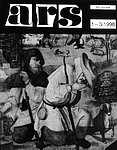
Časopis ARS 31 (1998) 1-3
József SISA
Mestský park (Aupark) v Bratislave[The City Park of Bratislava]
(Resumé)
The City park of Bratislava (Pressburg, Pozsony) was laid out on the south bank of the Danube River across the city as early as 1775 - 1776. In conformity with the baroque principles of garden design, and probably influenced by the Vienna Prater, its geometrical plan was composed of eight avenues arranged in four diagonals and a round space at the centre. Hence its first German name, Sternallee, or Star Allée. A restaurant, a dancing hall and vendors' tents offered refreshments and amusement to the citizens. In 1825 a pontoon bridge replaced the ferry, which made the park more accessible; soon afterwards a more elegant café and an open-air theatre (Arena) were constructed.
In 1832 the mayor of the city commissioned the German garden designer Karl Ritter to turn the Sternalee (at that time still an unkempt grove) into a landscape park. Ritter transformed the system of straight avenues into winding paths, though he kept the central space and the institutions of lower and middle class sociability. Clumps, as well as some place flower beds, were planted. In 1848 Flóris Rómer (the future archaeologist and art historian) laid out a small botanic garden in the park and even held lectures on botany to his fellow citizens.
The City Embellishment Committee, founded in 1868, regarded the maintenance and improvement of the City Park one of its priorities. An inspector was appointed; the first one, Adam Kosziba, was followed by Ludwig Schmidt, and then by Paul Zednik, the latter two being also head gardeners of the city of Bratislava. Thanks to their activities the horticultural standards of the park increased steadily. In 1868 a conservatory was erected in the northwestern corner of the area, which also provided whatever plants were needed in other public parks of the city. In 1868-71 a coach and horse riding way was laid out along the edges of the park from designs by the engineer Anton Sendlein, in order to lure more distinguished visitors.
The system of paths and roads was becoming gradually denser, in the centre a succession of parterres was created. At the same time exotic trees were added to the indigenous ones. Ornamental and utilitarian objects, such as small statues, vases and benches multiplied. In 1896, the year of the millennium, an ornamental structure was composed of the carved stones of the spire of the medieval Franciscan church.
In 1902, the park accommodated the national agricultural exhibition. At the turn of the century several sports facilities were laid out here, especially along the edges of the area. This reflected a new concept of park use and affected the aspect of the City Park.